Education and Sustainability Habits – Portuguese Students’ Perspectives
 , Clara Viegas1
, Clara Viegas1 , Alexandra R. Costa2
, Alexandra R. Costa2 , Claudia Orozco-Rodríguez3
, Claudia Orozco-Rodríguez3 , Gustavo R. Alves4
, Gustavo R. Alves4 and André Vaz Fidalgo4
and André Vaz Fidalgo4
Journal of Engineering Research and Sciences, Volume 4, Issue 7, Page # 15-25, 2025; DOI: 10.55708/js0407002
Keywords: Sustainable Development, Education, Online Resources, Attitude, Behavior
(This article belongs to the Special Issue on SP7 (Special Issue on Multidisciplinary Sciences and Advanced Technology (SI-MSAT 2025)) and the Section Education and Educational Research (EER))
Export Citations
Cite
Lima, N. , Viegas, C. , Costa, A. R. , Orozco-Rodríguez, C. , Alves, G. R. and Fidalgo, A. V. (2025). Education and Sustainability Habits – Portuguese Students’ Perspectives. Journal of Engineering Research and Sciences, 4(7), 15–25. https://doi.org/10.55708/js0407002
Natércia Lima, Clara Viegas, Alexandra R. Costa, Claudia Orozco-Rodríguez, Gustavo R. Alves and André Vaz Fidalgo. "Education and Sustainability Habits – Portuguese Students’ Perspectives." Journal of Engineering Research and Sciences 4, no. 7 (July 2025): 15–25. https://doi.org/10.55708/js0407002
N. Lima, C. Viegas, A.R. Costa, C. Orozco-Rodríguez, G.R. Alves and A.V. Fidalgo, "Education and Sustainability Habits – Portuguese Students’ Perspectives," Journal of Engineering Research and Sciences, vol. 4, no. 7, pp. 15–25, Jul. 2025, doi: 10.55708/js0407002.
Even though the use of technology in Education grew during the COVID Pandemic and some habits even contributed positively regarding the planet sustainability, after five years what can be said about students’ perception about it? This work is a follow-up to a previous study made shortly after academic life resumed its normality. A student questionnaire was conducted, and the results showed that the more awareness they presented about sustainability issues, the more they were favorable to a hybrid educational regime. In this paper the former questionnaire was adapted and performed to students during the 2023/24 academic year. Portuguese students’ perception about online productivity (usage of online resources and online classes) and sustainability (sensibility regarding transportation, food consumption and use of resources) were addressed, using an exploratory quantitative methodology. Students are still using a variety of online resources, which they consider to be effective and productive for their learning. In terms of sustainability, students show a stronger tendency towards sustainable food consumption and resource management. Finally, a comparative study was conducted to understand the changes in their perception (from 2021 to 2024), and their perception of online productivity seems to have changed little. In terms of sustainability, the results suggest students have already incorporated sustainability habits into their daily lives.
1. Introduction
The importance of education is widely acknowledged as one of humanity’s most significant achievements, primarily due to its universal accessibility and its capacity to facilitate a more prosperous future [1]. The development of the next generation depends on how they are informed and educated [2,3].
The impact of the COVID-19 pandemic was perceived in various dimensions. Some scientific studies have indicated that a favourable consequence of the global lockdown measures implemented in response to the pandemic was an enhancement of the Earth’s environment [4]. This has been evidenced by a decline in carbon dioxide levels, which has become more readily apparent. In terms of education, the question is whether the insights gained can be used to encourage more substantial and long-lasting changes in sustainability habits, such as using online resources more often or improving individual sustainability habits.
Educational institutions have underscored the significance of online accessibility. This has demonstrated that, with the appropriate technological resources, it is feasible to conduct lectures, meetings, and even experimental classes [5]. Many resources were developed and, in some cases, are still in use, reducing the time teachers and students might spend commuting.
With respect to the field of education, it is crucial to assess the potential value of incorporating online features. If educators and learners identify some of these features as being productive and demonstrate a favourable impact on sustainability, it would be advisable to think about it.
The objective of this study is to ascertain how students perceive online education productivity and sustainability habits after four years of the pandemic. This study represents a continuation of a previous investigation conducted after the return to face-to-face classes, which focused on students’ habits [6]. That study was conducted in 2021, immediately following the return to face-to-face classes, with the objective of understanding the strengths of the learning activities during the pandemic and the respondents’ preferences regarding the permanence of these activities. Additionally, the study sought to ascertain whether there had been any shifts in respondents’ habits concerning sustainability. Moreover, the present study aims to compare the habits and opinions of students regarding sustainability, online educational resources usage and productivity from the 2020/21 and 2023/24 academic years. This comparison is intended to identify any potential differences.
The structure of the paper is as follows: in section 1 an introduction was made, contextualizing the research problem. In section 2 a literature review of contributions is presented, showing how education and sustainability have been addressed in the academic community, including the growth of a sustainability consciousness. In section 3 the research design used in this work is described. In section 4: the results and discussion are presented, leading to some conclusions and final remarks in section 5.
2. Education and Sustainability
The concept of sustainability has become a matter of general concern in contemporary society. The notion of sustainable development has been cited extensively in recent discourse, particularly in the context of climate change. The most quoted definition of sustainability refers: “…development that meets the needs of the present without compromising the ability of future generations to meet their own needs” [7]. In 2015, a set of 17 Sustainable Development Goals (SDG) was adopted by United Nation (UN) countries with the objective of achieving a better and more sustainable world for all by 2030. These goals address the global changes currently being experienced, including those related to poverty, inequality, climate change, environmental degradation, peace and justice [8]. The fourth goal, entitled ‘Quality Education’, is the foundation for the improvement of people’s lives and sustainable development. This is achieved not only through the improvement of the quality of education but also aiding the comprehension of the significance of these concerns among younger generations [8].
The issue of sustainability can be approached from a variety of perspectives, including those of energy and resources, social and cultural, economic and political. These are all necessary to ensure the preservation of this planet for future generations [5,9,10]. From an environmental standpoint, the impact of resource usage on the planet’s resources can be examined [11]. From a social and cultural perspective, the impact of social behaviours on significant issues, such as clothing, nutrition, social interaction, and more, can be examined [12,13]. From economic and political standpoints, the influence of economic lobbies on global populations, often unconsciously, can be analysed [14].
Education, when viewed holistically, can be defined as the process through which teachers and students socialize professionally, with the social behaviours of a community exerting a significant influence on individuals’ thinking and actions regarding significant issues. Higher education is typically characterized by the presence of highly intelligent individuals who are still developing. This provides considerable potential for stimulating discussions about various aspects of our planet’s sustainability in both formal and informal settings [15]. In fact, the integration of sustainability principles within the educational curriculum is a pivotal aspect of promoting environmental awareness and responsible conduct. Irrespective of the content of the course, educators can adopt a pedagogical approach towards the importance of some of these issues in various ways, including incorporating it into existing courses, conducting contextualized activities, or implementing more sustainable procedures [16]. It is imperative to foster active student participation, encouraging more sustainable solutions from schools and from the educational community. In this manner, education evolves into a catalyst for change, empowering students to make more informed decisions and contribute to a future that is both balanced and sustainable.
The pandemic has prompted an array of unprecedented challenges within the educational sector, thereby accentuating existing inequalities and hastening an accelerated demand for innovative pedagogical approaches. The necessity for remote learning, precipitated by school closures, has exposed the disparity in students’ access to technological resources, thereby exacerbating the digital divide. Still, the pandemic also encouraged pedagogical innovation, with the development of new skills in autonomy, adaptability and digital tool mastery among teachers and students alike. This has resulted in dynamic and interactive teaching methodologies that make learning more accessible and diverse for a range of students’ profiles. These methodologies address some students’ difficulties by allowing them to practice (24 / 7) anytime, anywhere [17]. It has catalysed digital transformation in education, encouraging the adoption of new tools and hybrid methodologies with the potential to enhance teaching methodologies nowadays and, in the future [18–20].
Before the Pandemic, remote laboratories, online courses, and universities were already well established, but during this phase, their demand was overwhelming [17]. Even though there were many papers addressing the Pandemic transformation in education, there is a gap regarding the continued use of the tools developed at that time and the students’ perception regarding their use as well as studies on their sustainable habits that may have changed and that could both contribute positively to a more sustainable education. The objective of this study is to identify a set of educational online resources that have been found to be productive and capable of reducing ecological footprints, as perceived by students [16] are still in use and well received by students. The study also seeks to make a comparison between the results obtained in 2023/24 and those from 2020/21, with a view to understanding whether there has been any alteration in the perception of sustainability issues among students. It is imperative to evaluate their perception, given its significant influence on individual behaviour [21].
3. Methodology
As previously outlined in the introduction, this study constitutes a follow-up to the [6] study. Adhering to the research methodology employed in the aforementioned study, a questionnaire was validated and disseminated within the educational community. This questionnaire employed a descriptive research methodology, utilizing an internet-based survey to collect pertinent quantitative data [22]. In this study, the previously validated questionnaire was only partially utilized, as the section addressing the impact of the pandemic on students’ lives was deemed irrelevant for the present investigation. The questionnaire was adapted, and some questions underwent slight modifications to clarify participants’ perceptions regarding sustainability issues. The questionnaire was developed in three languages (English, Portuguese and Spanish) and disseminated via the Google Forms platform among academic communities by institutional mail and researchers’ (national and international) contacts. The distribution period was from March 2024 to September 2024, with the objective of achieving a sample that was as representative as possible of the target population, whilst also considering the heterogeneity of the schools’ areas of expertise. It should be noted that the study is a convenience sample, with most participants drawn from the Higher Educational Institutions where the authors work. For the purposes of this study, the analysis was limited to data from students who had studied in Portugal.
Following the previous research problematic about the better understanding of how education may contribute to a more sustainable development (SD) of the planet, this work intends to perceive changes in students’ perceptions (compared to the previous results, short after the Pandemic restrictions were lifted). Some resources developed during the Pandemic are still in use in academia, how do students feel about it? Furthermore, this study will tackle significant differences between groups (age, area of expertise, educational level). So, the research question in this paper is: “Have students’ perceptions regarding sustainability issues and the productivity of online classes changed since the post-pandemic phase?”.
3.1. Questionnaire description
An anonymous questionnaire composed of 14 questions was administered to students to assess their perspective on several issues related to education and sustainability habits. As this study forms a follow-up to one conducted shortly after the lifting of pandemic restrictions, it also sought to ascertain whether participants held differing views since that time. Therefore, the questionnaire included questions designed for this effect. The first question related to the acknowledgement of the respondent’s willingness to participate in the research study by completing the questionnaire. The second question sought to ascertain whether the participant was enrolled in any level of education during the 2023/24 academic year, with the objective of obtaining the perspective of students who were actively engaged in education at that time. Questions 3-8 pertained to the characterization of the sample, encompassing the area of education, level of education, teaching regime, and demographic information such as age, country and city of residence, and education. Questions 9 and 10 enquired about commuting habits, specifically the time spent and the usual mode of transportation. Questions 11 and 12 focused on classes and resources, investigating the continued utilization of resources adopted during the pandemic and the perception of productivity among different types of online classes or sessions. Question 13 addressed sustainability habits concerning various issues and their post-pandemic changes. Finally, question 14 was of an open nature, inviting respondents to provide any further contributions that had not been addressed in the preceding questions. All the questions, except question 14, were mandatory.
3.2. Sample characterization
In the study conducted in 2021 [6], a total of 315 students participated in the survey. Most of the participants were from Portugal (82%), and the majority of these were enrolled in higher education. In 2024, the number of respondents increased to 855, with 247 of these respondents being from Portugal. In this paper the authors will address the Portuguese students’ contributions to have a similar group in both questionnaires (2021 and 2024). The remaining data is being addressed in another work from the authors. The differences between the two samples are outlined in Table 1.
The sample was selected based on convenience sampling, meaning that participants were chosen due to their accessibility and availability. It is important to note that this type of non-probabilistic sampling does not require statistical significance testing, as it does not aim to generalize findings to a broader population but rather to provide a descriptive understanding of the phenomenon under study [23]. This longitudinal study examined Portuguese students’ responses collected in 2021 (n = 259) and 2024 (n = 247), aiming to maintain a comparable sample across both time points, maintaining similar contextual conditions over time was essential. The proportion of students enrolled in higher education increased from 56% to 79%. In terms of academic background, Science and Engineering became more prominent, rising from 32% to 52%, while Health grew from 8% to 19%. Conversely, participation from Arts and Design (15% in 2021) was no longer significant in 2024, and students from Administration, Communication, and Social Sciences declined slightly (from 23% to 18%). There was also a slight shift in the age distribution: while students aged ≤20 remained the largest group, their proportion decreased from 62% to 56%; students aged 21–27 remained stable (34% to 36%), and those aged ≥28 increased from 4% to 7%, suggesting broader age diversity in 2024. These changes reflect both demographic evolution and possible contextual influences affecting participation.
Table 1: Sample characterization of the studies from 2021 and 2024 (Portuguese students)
Sample | 2021 – students | 2024 – students |
Total valid answers | 259 | 247 |
Level of education | 56% higher education | 79% higher education |
Area of education (largest groups) | 32% Science & Engineering 15% Arts and Design 8% Health 23% Administration, Communication and Social Sciences | 52% Science & Engineering 19% Health 18% Administration, Communication and Social Sciences |
Age (largest groups) | 62% ≤ 20 years old 34% 21-27 years old 4% ≥ 28 years old | 56% ≤ 20 years old 36% 21-27 years old 7% ≥ 28 years old |
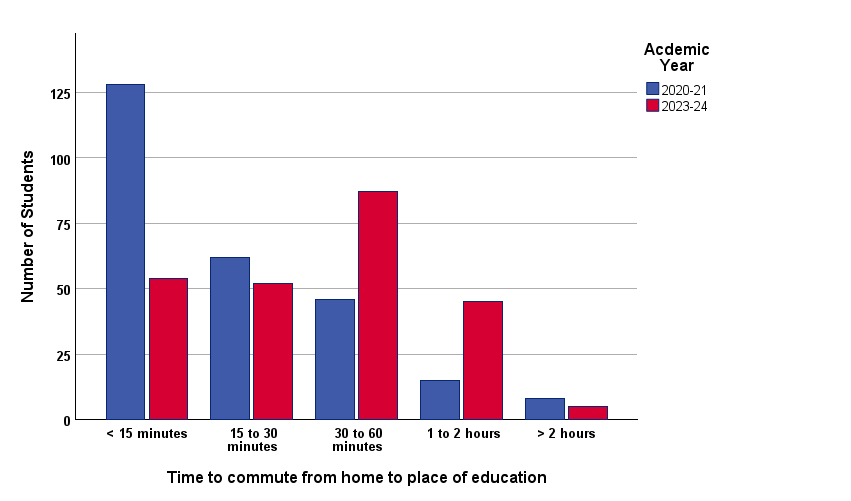
So, largely the educational community sample is from higher education, especially in the 2024 data collection. However, one limitation is the relatively small sample size, which may affect the generalizability of the findings.
A variety of transportation modes are used by students to commute from their place of residence to their place of education. The choice of method varies according to circumstances and the time taken for the journey is subject to variation (Figure 1).
3.3. Dimensions and categories definition
The present study encompasses two major dimensions pertinent to education and sustainability (Table 2). The first one, designated as “Online Productivity”, pertains to the students’ perceptions regarding the utilization of online educational resources (avoiding unnecessary commutes to school) and the productivity of online classes. With respect to online resources, students were requested to identify those they had been utilizing since the pandemic. For each type of online class, students were asked to rate its effectiveness on a scale from 1 (low effectiveness) to 3 (high effectiveness). They were also given the option to select “don’t know/not applicable” if they were uncertain. The second dimension, named “Sustainability”, pertains to various sustainability parameters, including transportation, food consumption habits, resource management and waste issues. Participants were asked to rate the relevance of each issue to their personal practices on a scale from 1 (not relevant) to 5 (highly relevant). Additionally, participants were given the option to select “not applicable” or “I already did it before the Pandemic “, the latter (with the highest score) serving to ascertain whether the pandemic had prompted any long-term shifts in behaviour.
Table 2: Dimensions and categories
Dimension | Categories | Issues |
Online Productivity | Online resources | online laboratories, simulations, videos, online meetings with teachers, online meetings with peers |
Online classes | theoretical classes, problem-based classes, experimental classes, students’ support, working sessions/meetings, only in small groups, only in large groups, only when interactive, only when lecture, only when actively producing work | |
Sustainability | Transports | public transport, private transport (even when there were alternatives), effort to give or ask for a ride, effort to use bicycle or similar |
Food consumption | mainly homemade food, avoid takeout food, use of lunch boxes, use of leftovers, reduction on the consumption of animal products | |
Resources | reduction on the use of paper, water waste, plastic bottles; use of circular economy (secondhand clothes, books, etc.) |
The variable “ecological footprint” was defined considering the type of transport used to commute (home – place of education) in order to easily assess this impact: 0 – foot, bike; 1 – mainly public transports; 2 – private vehicles.
The variable “productivity of online classes” was defined as the median of their answers to questions 12, which focused on the perception of productivity of 10 different types of online classes or sessions. The variable “global sustainability” was obtained by taking the median of their responses to question 13, which asked about their sustainability habits in relation to 12 different issues and how these had changed since the pandemic. The variable was divided into the categories: transport (4 issues), food consumption (5 issues) and resources (3 issues), according to the three categories considered in question 13.
3.4. Methodology in the Analysis Process
In order to identify the factors influencing students’ perceptions of sustainability and productivity, an exploratory quantitative approach was employed, incorporating both descriptive and inferential statistical techniques, with particular use of non-parametric methods due to the nature of the data. To understand which factors, affect students’ perceptions of sustainability and productivity, the nonparametric (Spearman) correlation procedure has been used, as the variables in study do not follow a normal distribution [24,25]. The former procedure establishes the possible relation/association between the study variables, and the correlation coefficient (varies from -1 to 1) describes both the strength and the direction of the relationship.
The best way to assess if there are differences and if they are statistically significant is to use a difference test, which is a statistical procedure that looks for the difference between the average of the study variables considering a particular factor. As the variables in study did not follow a normal distribution, we opted for the nonparametric Mann-Whitney U test and the Kruskal-Wallis test respectively for two independent samples and three or more independent samples (significance level 5%). The former tests compare the sample average that comes from the same population and are used to test whether the sample averages are equal or not. After defining the null hypothesis (H0: there are no statistically significant differences between the average of the groups) and if the obtained p < 0.05 there is a statistically significant difference between the average of the groups and the null hypothesis is not supported [24]. Unfortunately, these tests do not allow us to identify clearly where the differences lie between the two groups, so it must be complemented by a crosstabulation to identify where the differences lie.
4. Results and discussion
This section will present a global analysis on the 2024 survey, divided into the results obtained about students’ perceptions (4.1) and the identification of factors affecting student perceptions (4.2). Then, on section 4.3, a comparison between students’ perception in 2021 and 2024 is made.
4.1. Students’ Perceptions
Most students experience a face-to-face class regime, although 4.9% attend a hybrid regime and 1.6% an exclusively online regime. Even though 71 students (28.7%) state that they do not use any online resources, a significant number of students still have several online resources in use. (see Table 3), with the video being the most popular. Furthermore, 26.3% of students utilize two online resources, while approximately 10% are using three or more.
Table 3: Online Resources Usage
Online Resource | # Students | % Students |
Online laboratories | 3 | 1.2 |
Simulations | 23 | 9.3 |
Videos | 125 | 50.6 |
Online Meetings with Teachers | 70 | 28.3 |
Online Meetings with Peers | 76 | 28.7 |
Considering their perceived productivity of online classes (Figure 2), the ones that work better for them are classes in small groups, students’ support and working sessions / meetings. The less productive are experimental classes.
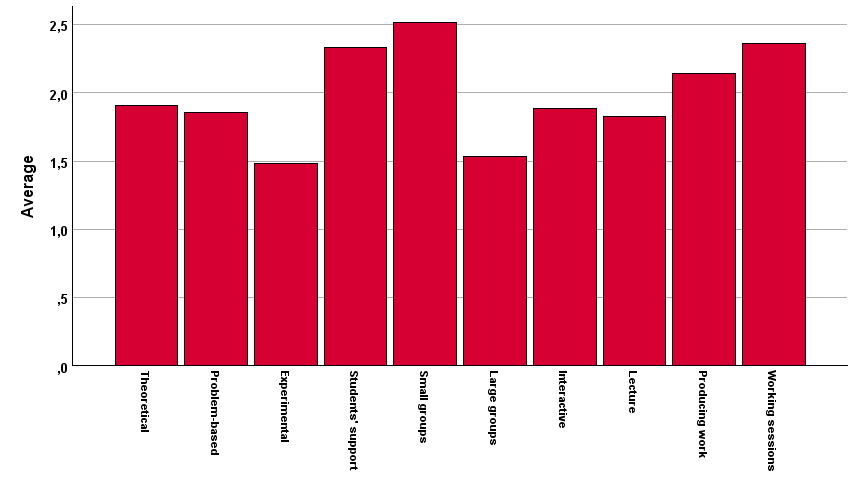
In Figure 3, the median values of the variable “productivity of online classes” are shown. The most prevalent median is 2.0, reported by 61% of participants. Remembering that for each type of online class, students were asked to rate its effectiveness on a scale from 1 (low effectiveness) to 3 (high effectiveness), this finding indicates that most participants perceived their productivity to be at an intermediate level and 25% considered it highly productive.
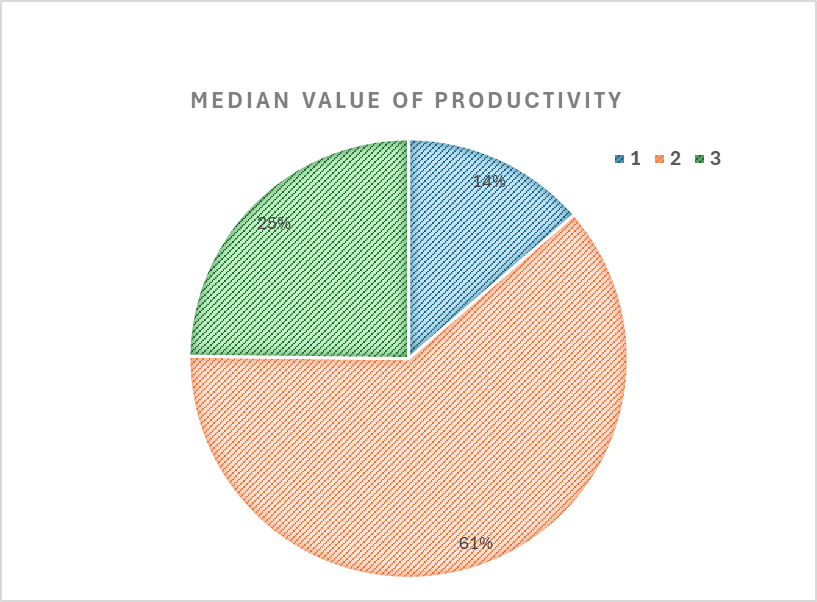
In the context of the sustainability dimension, students utilize diverse modes of transportation for their commute between their place of residence and their educational institution. Figure 4 provides a visual representation of it by ecological footprint. It was found that approximately 24% of the study’s participants have a high ecological footprint, indicative of significant environmental impact.
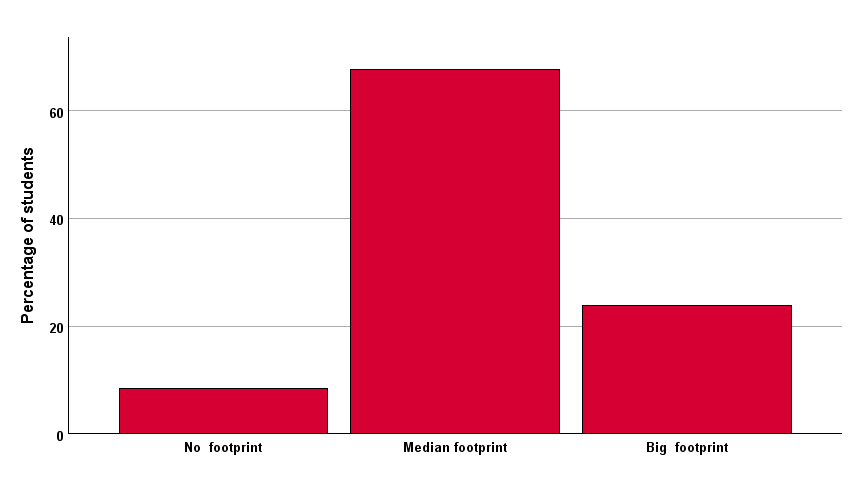
In relation to the second dimension, Sustainability, Figure 5 exhibits the 3 sustainability categories, covering Transport, Food consumption and Resources. Students exhibit a stronger tendency toward sustainable food consumption and resource management. The Portuguese population has a strong tradition of home-cooked meals and a preference for reusable food containers, commonly referred to as “lunch boxes”. Furthermore, most individuals exhibit a low reliance on food delivery services. Furthermore, Portuguese educational institutions have been observed to demonstrate a greater commitment to the reuse of resources and the reduction of waste, particularly regarding water conservation and the limitation of plastic and paper usage.
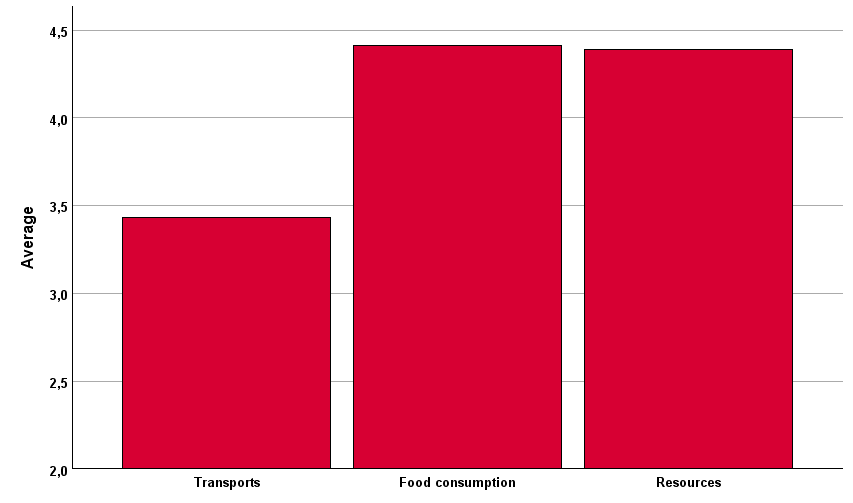
For the ‘global sustainability’ variable (see Figure 6), the most common median is 6.0, reported by 34% of respondents. In this question, participants were asked to rate the relevance of each of the 12 sustainability issues to their personal practices on a scale of 1 (not relevant) to 5 (very relevant). In addition, participants were given the option of selecting ‘not applicable’ or ‘I was already doing it before the pandemic’, the latter (at the higher level of 6) to ascertain whether the pandemic had led to any long-term changes in behavior. This finding suggests that many participants perceive their sustainability to be at a high level, i.e. they have already incorporated sustainability habits into their daily lives. In any case, the pandemic seems to have triggered a long-term change in behavior.
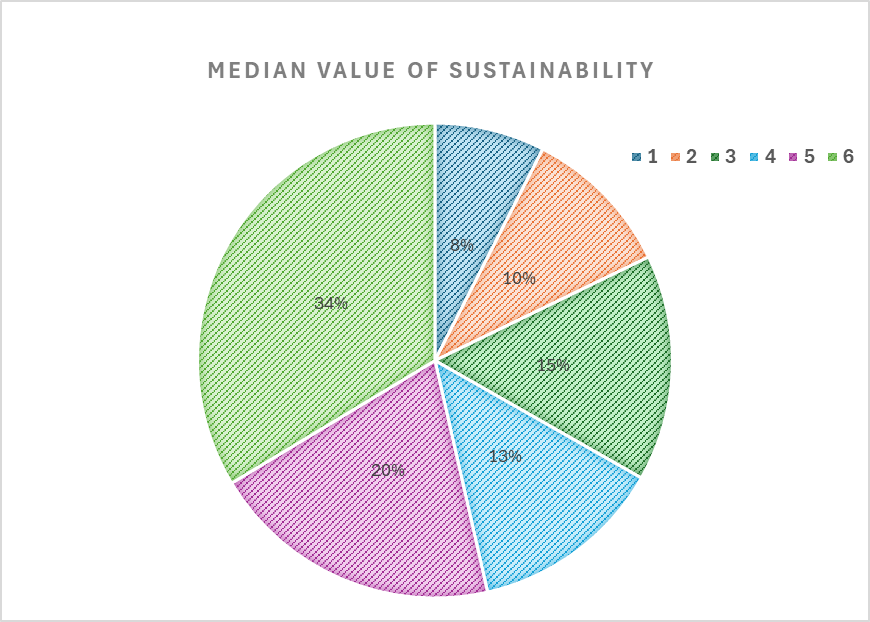
4.2. Identification of factors affecting student perceptions
As Portuguese students differ mainly in terms of age, educational area and educational level, correlations with these factors were analyzed. Some correlations were found between their age and both the time it takes to commute from home to school (rsp=0.128, p=-0.045, N=245) and the ecological footprint (rsp=0.143, p=-0.025, N=245). Thus, older students tend to spend more time commuting and also leave a higher ecological footprint. In fact, most of them are working students who sometimes travel by car directly from their workplace. Younger students, if they live away from home, tend to have accommodation close to their school. There is also a correlation between commuting time and the total number of online resources used by students (rsp=0.178, p=-0.018, N=175), suggesting that the more time students spend commuting, the more resources they use online, thus avoiding unnecessary travel to school. There was also a correlation found between class regime and perceived productivity of online resources (rsp=0.127, p=-0.049, N=242), i.e. students who use them more tend to find them more productive. Correlations were also found between all the items considered in the online resources category. No correlation was found between age or level of education with online productivity and sustainability.
Strong correlations were found between the sustainability categories, as well as a correlation between the transport category and the transport by ecological footprint. However, the study did not find any correlation between the two dimensions.
Non-parametric tests for independent samples were employed to ascertain whether the dimensions of online productivity and sustainability were influenced by students’ age, area of education and level of education. The analysis yielded statistically significant variations in the category of online classes productivity, both with respect to age and level of education (see Table 4). A subsequent cross-tabulation of these findings suggests that students in the 21-23 age range achieve higher scores in online class productivity. Furthermore, students pursuing higher education (i.e. bachelor’s degree) are also found to be more productive in online classes. This finding is further supported by the observation that students in this age group are typically more experienced and mature, often nearing completion of their undergraduate studies or already pursuing postgraduate education, having a heightened level of focus and motivation in their academic pursuits.
Table 4: Summary of “Online classes productivity” significant differences with age and level of education
Grouping variable | Median | x2 (Chi-Square) | p-value |
Age | 2.0 | 14.262 | 0.014 |
Level of Education | 2.0 | 9.996 | 0.040 |
4.3. Comparison between students’ perception in 2021 and 2024
To understand how Portuguese students’ perceptions have changed over time, we compared data from shortly after the pandemic restrictions were lifted (2020/21) with data from 2023/24. We used a statistical procedure (Mann-Whitney U test) described in Section 3.4 when possible. Because the questionnaires were slightly different, it wasn’t possible to use the earlier procedure for items ii and iv. But although the questions were posed differently, the items addressed in both were the same. So, for these ones, a comparison is made only regarding the overall results in each item and not directly for each question. Thus, the quantitative data collected was analyzed in both cases to understand if students’ perception about the former items has changed or not.
In fact, one of the goals of this work was to understand if the tendency of habits and opinions towards sustainability issues has changed.
In relation to the dimension of “Online Productivity”, this comparison allowed the following inferences:
- Educational resources they would like to keep using: the study was conducted for the common resources in both questionnaires (online laboratories, simulations, videos, online meetings with teachers, online meetings with peers); still in the first questionnaire it was about the resources they would like to keep using after the pandemic and the second one asked about the resources they are still using. Considering the total number of resources they would like/are using there is no statistically significant difference between the two groups and the same goes to online meetings with teachers and online meetings with peers. However, in 2021, students preferred online laboratories and simulations, while in 2024, students preferred videos (Figure 7). The 2021 preference can be explained by the fact that students spent a lot of time learning from these resources, some of which required extra effort to understand fully. At that point, students were reluctant to give them up if they found them useful. Since hands-on labs have been fully operational since then, students might not feel the same way in 2024. Interest in videos is growing more generally, and students are now more used to consuming them in both academic and social contexts. The number of scientifically helpful videos grew a lot during the Pandemic, and they are an easy way to quickly grasp a concept.
- Productivity of online classes/sessions: considering their perceived learning, the majority of 2021 students (51.4%) considered that online classes were productive only for some types of classes, especially those that promoted interaction (41.4%) and to a lesser extent theoretical classes (27.4%). Students (30.9%) also said they wouldn’t mind keeping a hybrid system, but only for some subjects/modules, and they chose theoretical classes (89.9%) as the ones they would keep. They also considered that student support (office hours) could be online, but with very little expression (5.2%). The students of 2024 think that online classes can work for: small groups (59.2%), working sessions/meetings (49.6%), student support (47.3%) and theoretical classes (26.1%). So, students’ perceptions of the productivity of online classes seem to have changed little, but they now seem to have a clearer idea of when it can be productive: for meetings, small groups or student support.
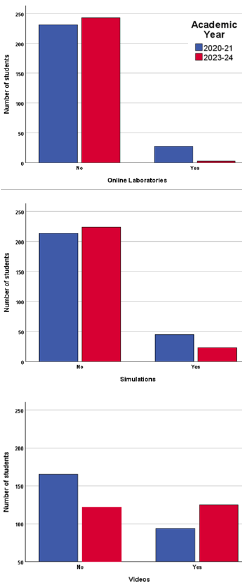
In relation to the dimension of “sustainability”, the comparison allowed to take the following inferences:
- The type of transport and the time spent commuting from home to school: there are no statistically significant differences in the type of transport used, but there is a statistically significant difference in the average time they spend on the commute: in 2024 students take more time (as could be inferred from Figure 1, in section 3.2). This could be because in 2021 the return to school was not in full. Since there is no significant difference between the types of transport, this difference in time spent might average that there are more students who come from further away. Overall, this was not an easy decision to make in the immediate aftermath of the pandemic.
- Sustainability habits: considering the 3 categories of this dimension (transport, food consumption and resources), a significant percentage of the 2024 students stated that they already had those habits before the pandemic, respectively 46.8 %, 46.4 % and 35.5 %. So, considering the former answer and the students that answered yes to the former questions, the percentages increased to 56.8 %, 63.7 % and 49.7 % respectively. These are significantly higher than the ones obtained in 2021, which were respectively 40.9 %, 33.2 % and 25.1 %. This suggests a heightened level of concern among students regarding practical sustainability issues these days.
4.4. Conclusion
Most of the Portuguese students inquired in 2024 recognized they still use several online resources, with video being the most popular. Overall, they considered online resources as being productive and identified the most productive for their learning as being the classes in small groups, students’ support and working sessions. In fact, students who use them more intensely tend to find them more productive. In terms of sustainability, students show a stronger tendency towards sustainable food consumption and resource management. Regarding transport, it was found that approximately 24% of the study participants – typically working and older students – have a high ecological footprint, indicative of significant environmental impact.
Compared to 2021, there was no significant change in students’ perceptions of the productivity of online classes. However, they now demonstrate to have a clearer idea of when it can be productive. Video has become more prominent, and students are now more accustomed to using it both in academic and social contexts. Students are also now more concerned about practical sustainability issues. The results suggest that they have already incorporated sustainability habits into their daily lives. In any case, the pandemic seems to have triggered a long-term change in behavior.
Regarding our research question: “Have students’ perceptions regarding sustainability issues and the productivity of online classes changed since the post-pandemic phase?”, our results point to a tendency of improvement of the students’ sustainable habits and their perception of the utility of some pedagogical online resources, but only in particular cases.
The findings of this study indicate that students have demonstrated an aptitude for using online tools, which may have consequences for both the pedagogical practices employed by students and the administration of higher education institutions. An overall contribution of this study is that students are open to the possibility of having some teaching classes or resources delivered online and this may represent a way to use b-learning as a more sustainable alternative since it reduces the transport negative effects, regarding that their schedule allows for them to reduce the number of days they need to attend the university. An important consequence is also the decrease in the time spent commuting. However, students are only open to that possibility if it does not represent hands-on practices, they consider it more productive to be face-to-face with the teacher and colleagues.
These findings also have several implications for key educational stakeholders, such as teachers or academic managers. Teachers should be encouraged to use online tools as complementary strategies to enhance flexibility, engagement and sustainability. They should be encouraged to use hybrid learning formats, particularly those incorporating support sessions and small-group activities. Academic managers should be sensitive to more flexibility in terms of classes schedules and the benefits of online moments, complementary to the hands-on essential classes. Conversely, policymakers and higher education institutions may wish to consider providing institutional support for hybrid education models that align with sustainability goals.
The observation of a considerable ecological footprint among the students in the analyzed sample suggests potential deficiencies in the availability or adequacy of local public transport alternatives. Consequently, this paper may have implications for territorial policy management, particularly by highlighting the necessity to develop transport options that are more aligned with students’ needs.
This work has limitations regarding the longitudinal comparison because some questions were slightly modified. Even though no direct conclusion has been made regarding each question, we acknowledge that this factor could have affected the results. Also, the population that answered both surveys was obviously not the same, and we cannot guarantee that external factors related to each group did not influence the responses.
Another limitation of this study lies in the inability to conduct qualitative triangulation, as the original instrument was not designed to collect data suitable for this type of analysis. Consequently, the results are presented solely from a descriptive quantitative approach. Additionally, the sample size represents another limitation, as it does not allow for broad generalization of the findings. However, this work should be understood as a starting point that provides an initial approximation of the reality under investigation. Based on this foundation, future research using mixed-methods approaches may be developed to achieve a more comprehensive understanding of the subject of study.
Conflict of Interest
The authors declare no conflict of interest.
Acknowledgment
The authors would like to acknowledge the partial financial support provided by the Foundation for Science and Technology through grants UIDB/04730/2020 and UIDP/04730/2020. The authors also like to thank all the persons involved in spreading and answering the questionnaire.
- Aguayo, C. Eames, T. Cochrane, “A framework for mixed reality free-choice, self-determined learning,” Research in Learning Technology, vol. 28, no. 2347, pp. 1–19, 2020, doi:10.25304/rlt.v28.2347.
- Publishing, B.A. Collection, C. Do, P. An, J. Haladay, S. Hicks, U.E. Account, Narratives of Educating for Sustainability in Unsustainable Environments, Michigan State University Press, East Lansing, 2021.
- Bakar, A. Ismail, eds., Sustainability of Higher Education A Global Perspective, Penerbit Universiti Sains Malasia, 2021.
- Nelson, “The positive effects of covid-19,” The BMJ, vol. 369, , 2020, doi:10.1136/bmj.m1785.
- Monge, “La pandemia obliga a renovar el contrato social,” Tiempo de Paz, vol. 139, no. Invierno 2020, pp. 72–82, 2020.
- Viegas, N. Lima, C. Felgueiras, A. Marques, G. Alves, R. Costa, A. Fidalgo, “How may teaching contribute to sustainability in a small scale but with wide use?,” in ACM International Conference Proceeding Series, Association for Computing Machinery, Barcelona: 794–799, 2021, doi:10.1145/3486011.3486558.
- H. Brundtland, Our Common Future: Report of the World Commission on Environment and Development, 1987.
- United Nations, SDG Site – Sustainable Development Goals, 2025.
- Wamsler, “Education for sustainability: Fostering a more conscious society and transformation towards sustainability,” International Journal of Sustainability in Higher Education, vol. 21, no. 1, pp. 112–130, 2020, doi:10.1108/IJSHE-04-2019-0152.
- Kumar, D.-S. Kim, eds., Sustainability Practice and Education on University Campuses and Beyond, Bentham Science Publishers – Sharjah, UAE, 2017, doi:10.2174/97816810847181170101.
- Bansard, M. Schöder, The Sustainable Use of Natural Resources : The Governance Challenge, pp. 1–10, 2021.
- Bentham, A. Wilson, M. McKenzie, L. Bradford, “Sustainability Education in First Nations Schools: A Multi-Site Study and Implications for Education Policy.,” Canadian Journal of Educational Administration and Policy, no. 191, pp. 22–42, 2019.
- Brunnquell, J. Brunstein, “Sustainability in Management Education: Contributions from Critical Reflection and Transformative Learning,” Metropolitan Universities, vol. 29, no. 3, 2018, doi:10.18060/21466.
- Scarpellini, Á. Gimeno, P. Portillo-tarragona, “Financial Resources for the Investments in Renewable Self-Consumption in a Circular Economy Framework,” Sustainability, vol. 13, no. 6838, 2021, doi:10.3390/su13126838.
- Barth, G. Michelsen, Z.A. Sanusi, “A Review on Higher Education for Sustainable Development – Looking Back and Moving Forward,” Journal of Social Sciences, vol. 7, no. 1, pp. 100–103, 2011.
- Blewitt, C. Cullingford, eds., The sustainability curriculum: Facing the challenge in higher education, Earthscan, London, 2013, doi:10.4324/9781849773287.
- M.B. Pavani, C. Viegas, N. Lima, G.R. Alves, A. Marques, A. Fidalgo, F. Jacob, J.B. Silva, S. Marchisio, L. Schlichting, F. Soria, F. Lerro, W. De S Barbosa, R. Steinbach, P. Mafra, “VISIR+ Project Follow-up after four years: Educational and research impact,” in 2023 IEEE Frontiers in Education Conference (FIE), College Station, TX.USA: 1–8, 2023, doi:10.1109/FIE58773.2023.10343298.
- Foster, The Future of Education: Lifelong , Flexible , Skill-Based Learning After COVID-19, https://www.autodesk.com/design-make/articles/future-of-education, 2021.
- Silva, Á. Sousa, “Perception of Teachers and Students about Teaching and Learning in the period of Covid-19 pandemic,” in ICERI2020 Proceedings: 13th International Conference of Education, Research and Innovation (ICERI2020), IATED Academy: 4832–4838, 2020.
- Curelaru, V. Curelaru, M. Cristea, “Students’ Perceptions of Online Learning during COVID-19 Pandemic: A Qualitative Approach,” Sustainability, vol. 14, no. 8138, 2022, doi:10.3390/su14138138.
- Viegas, N. Lima, A.R. Costa, “Engineering Students’ Perception on Self-Efficacy in Pre and Post Pandemic Phase,” Sustainability, vol. 15, no. 12, 2023, doi:10.3390/su15129538.
- Cohen, L. Manion, K. Morrison, Research Methods in Education, 6th ed., Routledge Falmer, London and New York, 2007.
- Hernández-Sampieri, C. Fernández-Collado, P. Baptista-Lucio, Metodología de la investigación , 7th ed., McGraw-Hill Education, 2023.
- J. Conover, Practical nonparametric statistics, John Wiley, New York, 1999.
- J. Marôco, Análise Estatística com o SPSS Statistics, 7a Edição, ReportNumber, Lda, 2018.
- Natércia Lima, Clara Viegas, Alexandra R. Costa, Claudia Orozco-Rodríguez, Gustavo R. Alves, André Vaz Fidalgo, “Enhancing Mental Health Support in Engineering Education with Machine Learning and Eye-Tracking”, Journal of Engineering Research and Sciences, vol. 3, no. 10, pp. 69–75, 2024. doi: 10.55708/js0310007
- Natércia Lima, Clara Viegas, Alexandra R. Costa, Claudia Orozco-Rodríguez, Gustavo R. Alves, André Vaz Fidalgo, “Educational Applications and Comparative Analysis of Network Simulators: Protocols, Types, and Performance Evaluation”, Journal of Engineering Research and Sciences, vol. 3, no. 6, pp. 18–32, 2024. doi: 10.55708/js0306003
- Natércia Lima, Clara Viegas, Alexandra R. Costa, Claudia Orozco-Rodríguez, Gustavo R. Alves, André Vaz Fidalgo, “Comprehensive E-learning of Mathematics using the Halomda Platform enhanced with AI tools”, Journal of Engineering Research and Sciences, vol. 3, no. 4, pp. 10–19, 2024. doi: 10.55708/js0304002
- Natércia Lima, Clara Viegas, Alexandra R. Costa, Claudia Orozco-Rodríguez, Gustavo R. Alves, André Vaz Fidalgo, “DC/DC Converter by using FPGA”, Journal of Engineering Research and Sciences, vol. 3, no. 3, pp. 13–18, 2024. doi: 10.55708/js0303002
- Natércia Lima, Clara Viegas, Alexandra R. Costa, Claudia Orozco-Rodríguez, Gustavo R. Alves, André Vaz Fidalgo, “Linking Consumer Innovativeness to the Cryptocurrency Intention: Moderating Effect of the LOHAS (Lifestyle of Health and Sustainability) Lifestyle”, Journal of Engineering Research and Sciences, vol. 1, no. 12, pp. 1–6, 2022. doi: 10.55708/js0112001
